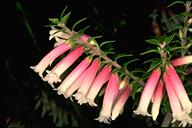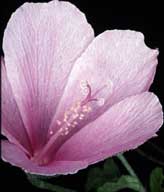

 |
Australian National Botanic Gardens
|
 |
A weekly news sheet prepared by a Gardens' volunteer.
Numbers in square brackets [] refer to garden bed Sections.
Plants in flower are in bold type.
18 May 2007
 |
Epacris reclinata - click for larger image |
Such wonderful Gardens in which to walk in this glorious autumn weather. This walk is mostly edging the far side of the Rainforest Gully. But first, Hakea ‘Burrendong Beauty’ [Section 221] seen at the bottom of the stairs in front of the Visitors Centre, is a prostrate spreading plant bearing lovely red pin-cushion like flowers enveloping the branch terminals. Edging Banks Walk, behind the seat Epacris reclinata [Section 174] is a small shrub clad with small tubular pink flowers dropping from its terminal branches while Epacris impressa [Section 174] has longer scraggy branches with similar flowers coloured deep pink. This plant is Victoria’s floral emblem. Opposite, between the rock shelves, a mint bush, Prostanthera phylicifolia [Section 210] is quite dense with many small mauve bugle shaped flowers while below, Hibbertia vestita [Section 210] is a small prostrate plant bright with open yellow flowers.
Walking along the Rainforest verge a wattle, Acacia fauntleroyi [Section 128] is a neat upright open small tree with narrow leaves and many golden yellow fluffy flower balls. Past the bollards containing names of many threatened species, Grevillea ‘Goldfever’ [Section 124] has apricot coloured spider-like flowers on this dwarf spreading shrub. Opposite the green Brittlegum Lawn [Section 107] Notelaea lloydii [Section 114] down the bank, is yet a small upright plant with narrow foliage and with clusters of cream buds and flowers, not very significant but will develop dark fruits. Acronychia littoralis [Section 114,104] is quite a tall dense shrub with shiny dark green leaves and clusters of lemon four-petalled flowers. Edging the Brittlegum Lawn [Section 107] Banksia spinulosa var. spinulosa [Section 109] is splendid with its upright cylindrical gold flower spikes ribbed with reddish styles. Behind the seat Hibiscus pedunculatus [Section 109] has long branches with small pink cup-shaped flowers among other shrubs, Grevillea ‘Robyn Gordon’ [Section 109] is a low spreading attractive shrub revealing its terminal clusters of cream-red flowers among its dense divided foliage.
Back, edging the Rainforest Gully, a ‘crafty chough’ is dining off the clusters bright orange fruits of the tall slim tree, Ehretia acuminata [Section 114]. Crossing over the Main Path, Bennett’s Ash, Flindersia bennettiana [Section 104] is a tall graceful tree with a heavy crown where its lateral branches have terminal sprays of large sprays of white flowers.
The triangle garden contains Epacris calvertiana var. calvertiana [Section 17], a wiry plant bearing white tubular flowers. Beside is a Geraldton Wax, Chamelaucium ‘Cascade Brook’ [Section 17] and in another corner, Dampiera salahae [Section 17] a suckering prostrate plant well covered with deep blue flowers. Across the road a grouping of Crowea ‘Festival’ [Section 123] looks magnificent with many deep pink star-like flowers.
 |
Hibiscus pedunculatus - click for larger image |
Taking the road where the yellow straw daisies, Xerochrysum sp. [Section 123] are so bright, to the Rock Garden, descending the stairs where the large Grevillea ‘Mason’s Hybrid’ [Section 15H] has large terminal clusters of red-lemon flowers and Grevillea lanigera [Section 15H] covers the ground with its red spider-like flowers. Below the Rock Garden, edging the road, an unnamed bottlebrush, Callistemon sp.[Section 110] has bright red flowers and further back, Callistemon ‘Glasshouse Mountains’ [Section 110] is a tall shrub with small pink bottlebrush flowers.
So many flowers to enjoy … Barbara Daly.